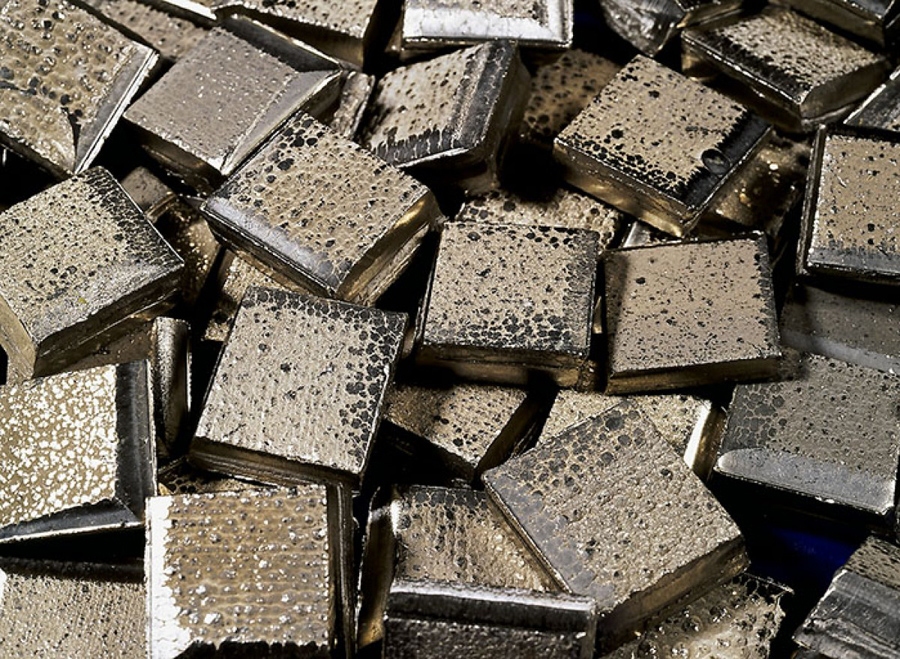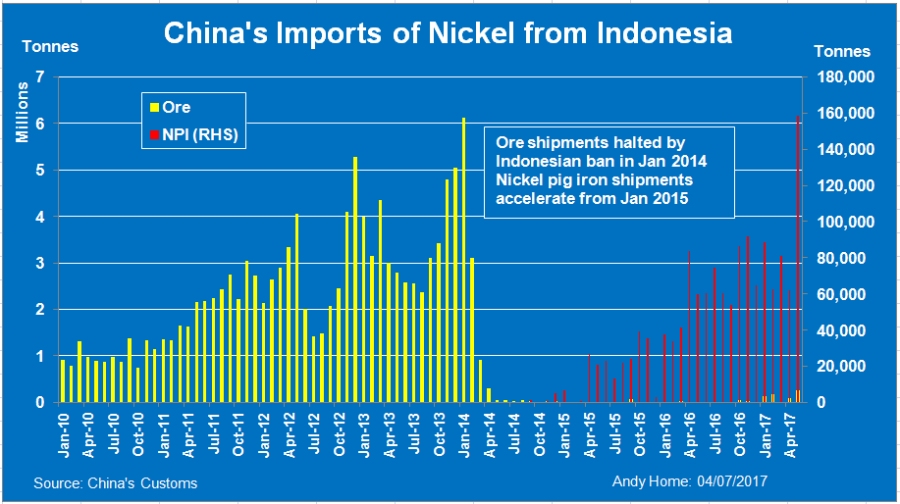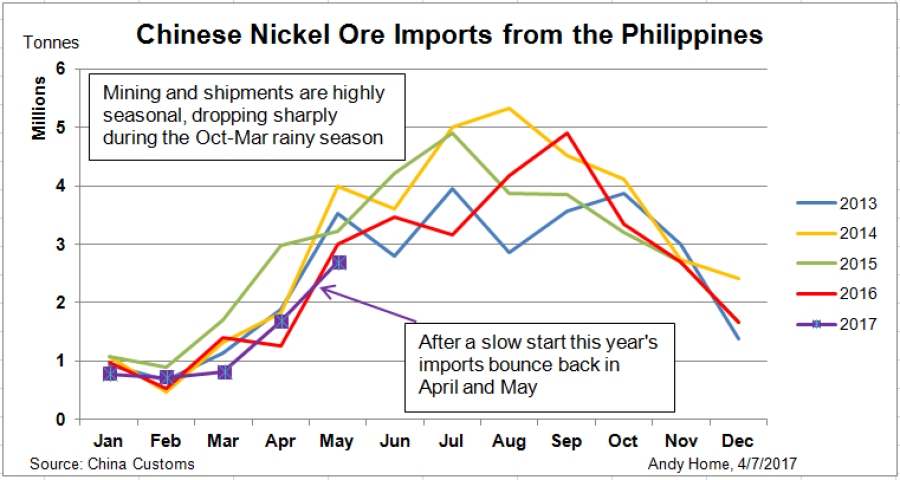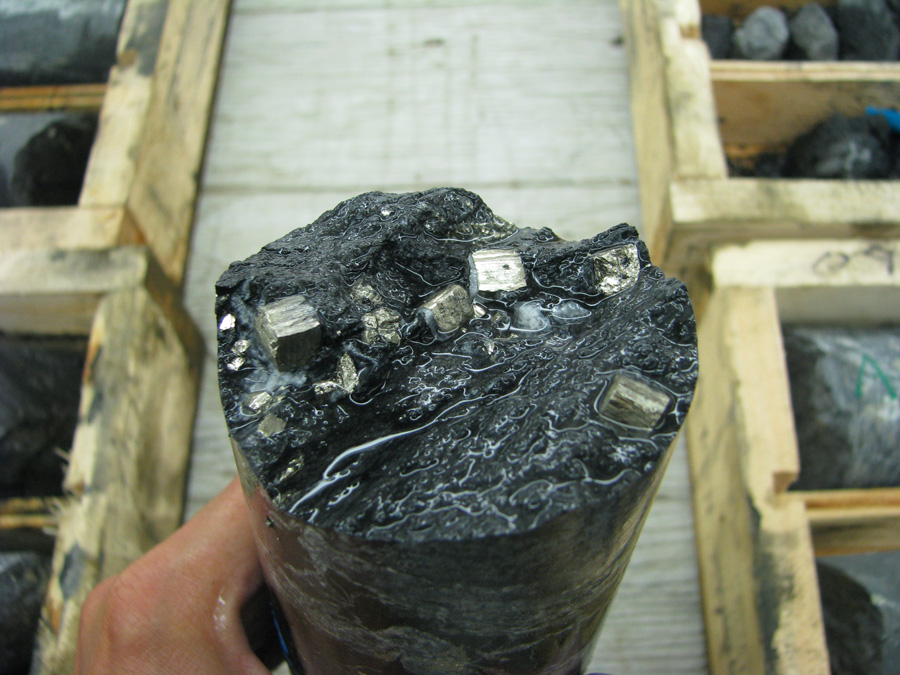As Indonesian nickel ore flows again to China, famine turns to feast: Andy Home

Nikkelverk refined nickel Norway. Image: Glencore
By Andy Home
LONDON, July 4 (Reuters) – The flow of Indonesian nickel ore to China has resumed after a three-and-a-half year break.
There have been a few false alarms since the Indonesian government banned all exports of unprocessed minerals, including nickel, at the start of 2014.
China’s trade figures have shown the occasional import of what has been classified as nickel ore but which was in all probability iron ore with high nickel content.
But May’s 264,000 tonnes seem the real deal. Not only was it the largest monthly total in three years but it tallies with plans by Indonesia’s Aneka Tambang (Antam) to make its first 150,000-tonne shipment at the start of the month.
It’s still a fraction of what Indonesia used to send every month to China before 2014.
The export ban remains in place but with a growing number of exemptions for companies that have committed to building processing plants.
For the Chinese nickel pig iron (NPI) producers that depend on such ore, it marks a dramatic turnaround from what looked like an existential crisis when Indonesia first cut off their supply.
Famine, however, has now turned to feast. Indonesian ore will add to a growing number of nickel raw materials flows into China.
And that spells trouble for the rest of the world’s producers.
Full breakdown of China’s nickel trade in May:
DOUBLING UP IN INDONESIA

Indonesia is not going to be supplying the same volumes of nickel ore to China as it did in 2012 or 2013, when imports reached 34 million and 41 million tonnes respectively.
The government is granting only a limited number of exemptions with limited tonnage quotas.
Antam, for example, has around five million tonnes of low-grade ore available for immediate shipment but so far has got approval to export only 2.7 million tonnes over the 12 months to March 2018.
But it is pushing for more.
And others are joining the list of approved exporters. The latest is PT Ceria Nugraha, which has received government permission to export 2.3 million tonnes through July 2018.
The quid pro quo for getting the official nod to export is construction of value-add processing plants within the country.
This was the whole point of the export ban and to some extent it has been achieved with the number of plants constructed now in excess of 20. Many of them, not entirely surprisingly, have been built by Chinese companies looking to off-shore NPI production.
There has been a steadily increasing flow of Indonesian intermediate material into China since the start of 2015. May’s imports of 158,130 tonnes were a fresh all-time high.
China’s customs department classifies this stuff as “ferronickel” but it’s not. The give-away is the price, an average $1,362 per tonne in May, compared with over $3,000 per tonne for imports from conventional ferronickel suppliers such as Colombia and Brazil.
PHILIPPINES DOWN BUT FAR FROM OUT

While China doubles up on Indonesian supply, it can now also feast on the alternative ore sources that arose after the 2014 export ban.
The Philippines emerged as the main source of replacement supply for Indonesian ore.
It was another part of China’s supply chain that seemed in imminent danger of collapse until a few weeks ago.
However, Regina Lopez, the Philippine firebrand environment secretary who wanted to close just about all the country’s nickel mines, has now gone.
Her replacement, Roy Cimatu, has taken a much more conciliatory approach and many of the targeted mines have continued operating anyway after filing appeals against Lopez’ closure orders.
China’s imports of Philippine ore looked to have fallen off a cliff in the first quarter of this year, plummeting by 20 percent to 2.3 million tonnes.
But they recovered strongly over the course of April and May with the cumulative year-to-date tally of 6.7 million tonnes down by a modest 7 percent on last year’s equivalent figure.
A particularly severe monsoon season and normal mine depletion have had a more significant impact than Ms Lopez.
Nor has the Philippines been the only country to have benefited from Indonesia’s shipping absence.
New Caledonia has redirected its ore shipments from the bankrupt and now shuttered Queensland Nickel refinery in Australia to China.
Chinese imports of New Caledonian material have more than tripled so far this year to 346,000 tonnes.
Other new ore suppliers now regularly appearing in China’s trade figures include Guatemala and Turkey with imports this year of 147,200 tonnes and 91,700 tonnes respectively.
REFINED NICKEL IMPORTS SLIDE
China’s massive NPI sector has survived two potentially killer supply blows in the form of the original Indonesian ban and last year’s threat of widespread mine closures in the Philippines.
It has emerged with a more geographically diverse nickel raw materials supply chain than ever before.
Rumours of its imminent demise, which have been plentiful in recent years, appear to have been seriously exaggerated.
But the flip side of its survival is a steady slide in China’s appetite for nickel in refined metal form.
Imports slumped by 57 percent to 83,400 tonnes in the January-May period from 195,000 tonnes in the same period of 2016.
Exports, meanwhile, jumped by 45 percent to 7,400 tonnes.
All of which is bad news for everyone else.
There are 446,000 tonnes of refined nickel sitting in London Metal Exchange and Shanghai Futures Exchange warehouses. There is almost certainly a lot more hiding in the off-exchange statistical shadows.
Lacking a bull narrative since the political demise of Ms Lopez in the Philippines, the London price is looking bombed out again just above $9,000 per tonne.
Which means it’s back to the cost-curve drawing board.
Brazil’s Vale confirmed on Tuesday it is reassessing its loss-making New Caledonian operations.
It won’t be the only nickel producer to be running the numbers again.
(Editing by Susan Fenton)
More News
{{ commodity.name }}
{{ post.title }}
{{ post.date }}

Comments